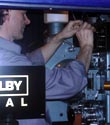|
|
This topic comprises 2 pages: 1 2
|
|
Author
|
Topic: Where is 1.66 and 1.75 used?
|
John Walsh
Film God

Posts: 2490
From: Connecticut, USA, Earth, Milky Way
Registered: Oct 1999
|
 posted 09-27-2000 08:39 PM
posted 09-27-2000 08:39 PM




In America, we pretty much only project 1.85 and 2.39. and if another country shows US films (and wants to show them correctly) they would have to project those ratios.What I am really interested in is: what ratios do other countries use? And since scope is pretty much the same everywhere, only films in "flat" will probably be different. I thought that (for example) "flat" in France is 1.75; and in Italy, "flat" is 1.66. Does anyone have a rule of thumb in case the distributor doesn't supply the ratio (or even know, which is usually the case.)
| IP: Logged
|
|
|
|
Nick Perry
Film Handler
Posts: 19
Registered: Feb 2000
|
 posted 09-28-2000 12:03 AM
posted 09-28-2000 12:03 AM




John,I have had to project many forign films at festivals in which no indication to ratio is given. The general rule I use is to first look at one frame of the feature aginst different apertures. E.g 1:85; 1:75; 1:66. What you need to look for is which aperture best fits the frame. E.g. If an unknown ratio print has subtitles start with a 1:85 aperture. If the 1:85 aperture crops heads or subtitles you need to go down a step to 1:75 and so forth. What you want to avoid is going to far that frame lines and boom mics getin the shot. Overall, all I worry about is that I am not cutting off heads and subtitles. Most prints in Europe are 1:66. Nick
| IP: Logged
|
|
Frank Prete
Film Handler
Posts: 55
From: Victoria, Australia
Registered: Sep 2000
|
 posted 09-28-2000 12:32 AM
posted 09-28-2000 12:32 AM




John,Cinemas in Switzerland and France both 1.75 and 1.85 is commonly used. Germany generally sticks to the main two. Czech Republic uses 1.75 & 1.85 as well as scope. In Asia, 1.66 is common amongst the local product, but the market generally goes for Blockbuster hollywood product anyway so 1.85 and scope have become the accepted standard. I remember the occasional 1.75 coming through - one called Blue Moon which had five spools, all colour coded. Each week the film would be broken down and reassembled into a different order. A little off the topic, but interesting none the less  . . Frank.
| IP: Logged
|
|
|
|
|
|
Dave Williams
Wet nipple scene

Posts: 1836
From: Salt Lake City, UT, USA
Registered: Jan 2000
|
 posted 09-28-2000 12:20 PM
posted 09-28-2000 12:20 PM





Disney is notorious for having rediculous formats for thier films.If I am not mistaken I remember TRON at 2.2:1 and Tarzan was at the 1.75:1 ratio. Disney, making most of its money in north america, still has a hard time realizing that here in the good ol USA have two primary ratios, and those aint them! (ok tron was a long time ago, but still!) Dave
| IP: Logged
|
|
|
|
Ian Price
Phenomenal Film Handler

Posts: 1714
From: Denver, CO
Registered: Jun 99
|
 posted 09-28-2000 02:44 PM
posted 09-28-2000 02:44 PM




Tron was a 70mm print, which can have a ratio of 2.2:1 (BKSTS says that a 65mm negative is filmed at 2.28:1 and by the time the 70mm print is finished the gate in the projector should be 2.2:1)I have always understood Europe to have 1.66:1 as their flat ratio. I have never heard of 1.75:1 but I have heard of 1.77:1. (BKSTS says 1.75 was known as “British Wide Screen”. This is practically indistinguishable from 1.78, which is the ratio of the 16x9 format proposed for Wide Screen Television. This format can be very efficiently provided by Super-16, as it utilizes 96% of the frame area.) We have been showing British movies in 1.85 for years with no problems. I guess they are splitting hairs here. But they have the best lenses for showing our 1.85:1 and France’s 1.66:1. 1.77:1 is the same as 16x9 in video. Prospero's book was shown in 1.77:1 because it was "photographed" in HDTV. I much prefer 1.66:1 as a film ratio than 1.85:1. 1.85:1 wastes too much film and looks the grainiest. (BKSTS says that they protect to 1.66:1 when they film 1.85:1 so as to protect against boom mikes and dolly tracks.) Hmmm, I wonder? We have shown some films recently in 1.37:1 and boy do they look good and sharp! We have forgotten more than we have ever known.
| IP: Logged
|
|
John Pytlak
Film God

Posts: 9987
From: Rochester, NY 14650-1922
Registered: Jan 2000
|
 posted 09-28-2000 03:07 PM
posted 09-28-2000 03:07 PM





I will be presenting a paper and film demonstration at the SMPTE Technical Conference in Pasadena on October 20. It clearly shows the advantages of a new format that uses the "scope" image area of 0.825 x 0.690 inches and a 1.5X anamorphic lens to give a 1.78:1 (16:9) aspect ratio. By simply buying a new lens, theatres would have 1.5X more light than the "flat" format, and pictures that are brighter, sharper, less grainy and more colorful.  ------------------
John P. Pytlak, Senior Technical Specialist
Worldwide Technical Services, Entertainment Imaging
Eastman Kodak Company
Research Labs, Building 69, Room 7419
Rochester, New York, 14650-1922 USA
Tel: 716-477-5325 Fax: 716-722-7243
E-Mail: john.pytlak@kodak.com
| IP: Logged
|
|
Leo Enticknap
Film God

Posts: 7474
From: Loma Linda, CA
Registered: Jul 2000
|
 posted 09-28-2000 06:05 PM
posted 09-28-2000 06:05 PM





The general rules of thumb I have come to expect are as follows:UK = mainly 1.85, made for TV productions 1.75/8 (e.g. 16:9) or 1.66 if you don't have a lens and plate. Some films, e.g. Girls' Night, Final Cut, are marked as 1.66. France = were almost exclusively 1.66, but seem to be moving towards 1.85, e.g. Ma Vie en Rose, L'Ennui. A greater proportion of French films tend to be scope, nowadays. Spain = about half and half. Germany/Italy = of films released in the last 5 years, I've never had a flat one which is not 1.85 hard matted. Denmark = as above, but 1.66. Former Soviet union countries = almost always 1.38. A Russian film we showed recently, 'Of Freaks and Men' was 1.66, so maybe the Russian film industry is in the process of changing. China = Of recent Chinese films, I've only ever had 1.85 and 'scope. Asian subcontinent = tends to be 1.66, but some 1.85. Assuming an Academy or full height aperture, I tend to find that if the framing of the action occupies a height of roughly 2 perforations, then the ratio is 1.85, if 3 then 1.66, any more then Academy.
| IP: Logged
|
|
|
|
|
|
Ari Nordström
Master Film Handler

Posts: 283
From: Göteborg, Sweden
Registered: Jan 2000
|
 posted 09-29-2000 03:19 PM
posted 09-29-2000 03:19 PM




Frank wrote...
>>"Cinemas in Switzerland and France both 1.75 and 1.85 is commonly used. Germany generally sticks to the main two. Czech Republic uses 1.75 & 1.85 as well as scope."<<Germany actually uses 1.66, 1.75, AND 1.85. I've run lots and lots of German films at the Göteborg Film Festivals every year since 1988, and my experience is that they still do more 1.66 (sometimes very narrowly matted but in a majority of cases specifically marked as "1.66", both on leaders and boxes--they almost never use cans  ) than anything else. I've NEVER seen a German print marked as 1.75, but I've seen a few marked as 1.85. 1.75 is almost never a German filmmaker's intended aspect ratio. ) than anything else. I've NEVER seen a German print marked as 1.75, but I've seen a few marked as 1.85. 1.75 is almost never a German filmmaker's intended aspect ratio. Actually, Scope has become more popular in Germany during the last year. I've screened two german Scope films in the last twelve months. French filmmakers use both 1.66 and 1.85. This goes back and forth, and now the tendency is to shoot 1.85 again. In Sweden, the 1.85 aspect ratio is sometimes called "french widescreen" by old-timers. Yeah, I use that term as well, but I'm not THAT old.  The Czechs seem to lean towards 1.85, yes, based on the few films I've shown the last few years. Frank wrote further: >>"In Asia, 1.66 is common amongst the local product, but the market generally goes for Blockbuster hollywood product anyway so 1.85 and scope have become the accepted standard."<< You kidding? Until pretty recently, Chinese movies were either 1.37 or (fairly rarely) 1.85, never 1.66. Scope's been unheard of, unless a foreign company's involved. Hong Kong flicks (especially the mass-produced action movies are almost always 1.85 and matted pretty tightly. I've run a few Scope films but again, it has seemed to coincide with foreign financing... Recent Japanese movies are almost all in 1.85, and matted so. They did quite a few Scope films twenty or thirty years ago (just take a look at old Godzilla flicks) but it's been quite a while since I last saw a Japanese Scope film. Indian films used to be either 1.37 or Scope, but I've seen one or two 1.66 prints in the last two years (I've run more of them than I care to admit). Most of the "major releases" (most of them three-hour musicals, it seems) are Scope. And now insufferable Dolby SR, I might add! In almost all cases re Asian film where the print seems to be 1.75, screen it in 1.85. The vast majority of theatres at all capable of showing widescreen (that is, "flat") over there have something that is supposed to be 1.85, and from time to time is... That's according to film festival people who watch zillions of films in Asia in preparation of the next festival.
| IP: Logged
|
|
Ari Nordström
Master Film Handler

Posts: 283
From: Göteborg, Sweden
Registered: Jan 2000
|
 posted 09-29-2000 03:55 PM
posted 09-29-2000 03:55 PM




Leo wrote:>>"UK = mainly 1.85, made for TV productions 1.75/8 (e.g. 16:9) or 1.66 if you don't have a lens and plate. Some films, e.g. Girls' Night, Final Cut, are marked as 1.66."<< The TV productions are often 1.85 because they were shot in Super 16. We sometimes get the Super 16 prints at the Göteborg Film Festival. But yeah, what you say is essentially true AFAIK. >>"France = were almost exclusively 1.66, but seem to be moving towards 1.85, e.g. Ma Vie en Rose, L'Ennui. A greater proportion of French films tend to be scope, nowadays."<< Again, true. I forgot to mention Scope in my earlier reply to Frank, but now that you mention it, I can recall several recent productions. (I could even name them if I had my notes handy...  ) ) >>"Spain = about half and half."<< They're going towards 1.85, probably because of some change in labs, equipment or the like. All of the Almovar (sp?) films have been 1.85, though, ever since the first I screened ("Women on the Edge of Nervous Breakdown"). No Scope, ever, AFAIK. >>"Germany/Italy = of films released in the last 5 years, I've never had a flat one which is not 1.85 hard matted."<< Weird. How many German films have you screened? Most of the ones I've screened are 1.66. Italy is about fifty-fifty, as far as I can remember. >>"Denmark = as above, but 1.66."<< Used to be, but lately I've noticed a tendency towards 1.85 from the younger filmmakers. I even got a print that was flat but matted as 2.35. Now THAT was weird. As for other Nordic countries, Sweden uses both 1.66 and 1.85, and the tiniest little bit of Scope. The majority of films shot is still 1.66 but the younger generation seems to want wider screen formats. The same goes for Norway, except that I've seen less Scope (but more 70mm!). Finland, again about the same, but more Scope (and no 70mm...) Iceland, finally, is shooting more 1.85, from what little I've seen (half a dozen films or so during the last two years, of which most were 1.85; those that weren't were 1.66). >>"Former Soviet union countries = almost always 1.38. A Russian film we showed recently, 'Of Freaks and Men' was 1.66, so maybe the Russian film industry is in the process of changing."<< They still shoot using old equipment, and most (old Soviet) cinemas still only have 1.37 and Scope, but filmmakers try to compose for 1.66 or 1.85, according to director Andrej Konchalovsky (sp?) whom I met at the film festival two or three years ago. He had made films in the US, and wanted to bring the 1.85 format back home with him, he said. The film company said no to a matted print but it was OK to compose for 1.85, which he did. Presumably others are doing the same, and I've actually seen one or two Russian prints with matted 1.66 (and Dolby A!) >>"China = Of recent Chinese films, I've only ever had 1.85 and 'scope."<< 1.85, yeah. Scope? A true Chinese production? Not that I don't believe you, but Scope's almost unheard of there in my experience. Do you remember a title? >>"Asian subcontinent = tends to be 1.66, but some 1.85."<< Mongolia 1.85. Bhutan (yeah they made their first feature last year, with help from Australia) 1.85. Hong Kong (before 1997) 1.85. India 1.37 and Scope. Etc. Generally speaking, every nation east of (but including) India uses 1.37, 1,85, or Scope. No, or very little, 1.66. The only nations in that general direction I can think of that use 1.66 are the Arabian nations (Iraq, Iran, etc). Do they count as Asian? On the other hand, I can be wrong. I've shown a few Asian films in my time, though, and my experience seems to differ from yours.
| IP: Logged
|
|
|
|
All times are Central (GMT -6:00)
|
This topic comprises 2 pages: 1 2
|
Powered by Infopop Corporation
UBB.classicTM
6.3.1.2
The Film-Tech Forums are designed for various members related to the cinema industry to express their opinions, viewpoints and testimonials on various products, services and events based upon speculation, personal knowledge and factual information through use, therefore all views represented here allow no liability upon the publishers of this web site and the owners of said views assume no liability for any ill will resulting from these postings. The posts made here are for educational as well as entertainment purposes and as such anyone viewing this portion of the website must accept these views as statements of the author of that opinion
and agrees to release the authors from any and all liability.
|

 Home
Home
 Products
Products
 Store
Store
 Forum
Forum
 Warehouse
Warehouse
 Contact Us
Contact Us




 Printer-friendly view of this topic
Printer-friendly view of this topic





 .
.














